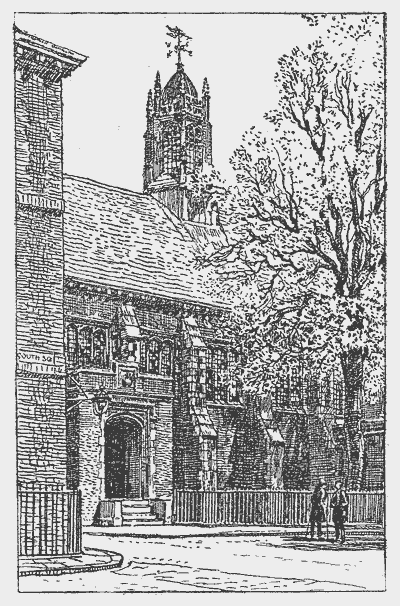|
GRAY'S INN
Gray's Inn |
|
The Coat of Arms or Ensign of Honour appropriated to this Honourable Society :—Sable an Indian Griffin proper segreant, with the inscription " Integra lex AEqui custos rectique magistra non habet affectus sed causas jure gubernat," which might be translated : "Inviolate law the Guardian of Equity and the Mistress of Right. To be subject to no influence but decide cases justly." Though the exact date at which Gray's Inn became solely and permanently the residence of members of the profession of the law is not positively ascertained, evidence exists to show that it was an Inn of Court early in the 14th Century. A manuscript in Heralds' College (Vincent 190) states : "Grayes Inne was some tyme the Inne or lodginge of the Ancyent and noble barons, the Lord Grayes, from whom it tooke the name . . . and estate of this house was taken in the Reigne of King E (dward) the 3 tyme by the gentilmen and professors of the common lawe, as Mr. St. Lowe Kinneton, a learned gentilman and a rare antiquarye and fellowe of this college, afirmeth out of his own serche and readinges of antiquityes concerninge this house." THE Hall of Gray's Inn, erected in the reign of Queen Mary, is 70 feet in length, 35 in width, and 47 in height, and is built upon the usual plan of the great halls of the 15th and 16th Centuries. At the eastern end is the raised dais on which is placed the chief table, and on the right is the bay window, a characteristic feature of the Tudor style. At the opposite end an oak screen conceals the entrance vestibule. There is a tradition in the Inn that this screen and also some of the dining tables in the east new hall were given to the Society by Queen Elizabeth as tokens of her regard. It might also be mentioned that at dinner on Grand Night in each term "the glorious, pious, and immortal memory of good Queen Bess" is still solemnly drunk in the Hall. Gray's Inn Notable Library was founded by Lord Events. Verulam, who as Francis Bacon became a member of the Inn in1576. One event is recorded in this form concerning Gray's Inn: " 22nd Feb., 1653-4 : The Lord Henrie Cromwell, second sonne to His Highness Oliver Cromwell, Lord Protector of England, Scotland and Ireland, is admitted into this Societie." His Royal Highness the Duke of Connaught is a member of Gray's Inn. At a special pension held on 4th July, 1881, all the ordinary rules and regulations of the Society were dispensed with, and His Royal Highness was admitted a member, called to the Bar and elected a Bencher. Some light is thrown upon the custom of dining in term by an order issued at an early period " that every quarter, once or more if need so required, the Readers and Benchers cause one of the officers to summon the whole company openly in the hail at dinner." CURIOUSLY enough, the word " Barrister " was not derived from the bar of a Court of Justice, but from the bar or rostrum at which exercises were performed in the whole of the Society. In the ancient times—that is, down to the 17th Century—a "call" to the Bar was not by the Governors or Bench- ers, but by the Reader of the Inn, who examined the candidates and advanced or kept them back according to their deserts. The readings at the Inns were interrupted during the Commonwealth. In 1657 the Cromwellian Parliament ordered " that it be recommended to His Highness upon advice with the Judges for reforming the government of the Inns of Court ; and likewise for the placing of godly and able ministers there; and provide a sufficient maintenance for their encouragement ; and also for reviving the readings in several Inns of Court, and of keeping up the exercises by the students there." Site Copyright ickledirectory.co.uk. The text was first written in 1910 by an anonymous diarist. |
